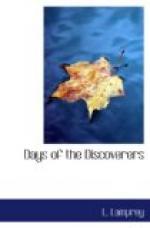Further questioning drew out information which sounded as if Coudouagny, or Canyengye, were a tribal god. In reality this was the word for “elder brother.” In that region it was applied to the Tekarihokens, the eldest of the five nations in the league of the Long House. They were afterward dubbed by their enemies the Mohawks or man-eaters, and the fear for the white men’s safety which the interpreters expressed may very well have been quite genuine.
But the Breton captain had not come across the Atlantic to give up his plans for fear of an Indian god, if it was a god, and his reply to the warning was to the effect that Coudouagny must be a numskull. More seriously he explained to the interpreters that although he had not himself spoken with the God of his people his priests had, and he fully trusted in the power of his God to protect him. The party set forth at the appointed time.
In about two weeks they reached the greatest Indian town that any of them had ever seen. It was not the walled city of the Norumbega legend, but both Maclou and Cartier had ceased to expect anything of that kind. The Indian guides had said that the town was near, and all were dressed in their best. A thousand Indians, men, women and children, were on the shore to receive them, and the commander at the head of his little troop marched into Hochelaga to pay their respects to the chief.
The Indian city was inhabited by several thousand people, living in wigwams about a hundred and fifty feet long by fifty wide, built of bark over a frame of wood, and arranged around a large open space. The whole was surrounded by a stockade of three rows of stakes twelve or fifteen feet high. The middle row was set straight, the other two rows five or six feet from it and inclining toward it like wigwam-poles. The three rows, meeting at the top, were lashed to a ridgepole. Half way down and again at the bottom cross-braces were fastened diagonally, making a strong wall. Around the inside, near the top, was a gallery reached by ladders, on which were piles of stones to be thrown at invaders. Instead of being square, or irregular with many angles and outstanding towers, like a French walled town, it was perfectly round.
The interpreters afterward explained that each of the houses was occupied by several families, as the head of each house shared his shelter with his kinfolk. When a daughter was married she brought her husband home, as a rule, and her father added an apartment to his house by the simple device of taking out the end wall of bark and building on another section. Each household had its own stone hearth, the smoke escaping through openings in the roof. A common passage-way led through the middle of the house. On the sides were rows of bunks covered with furs. Weapons hung on the walls, and meat broth or messes of corn and beans simmered fragrantly in their kettles. Some of these long houses held fifty or sixty people each, and there were over fifty of them in all. In that climate, with warlike neighbors, the advantage of such an organized community over scattered single wigwams was very great. All around were cleared fields dotted with great yellow pumpkins, where corn and beans had grown during the past summer.




